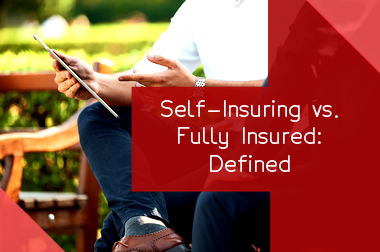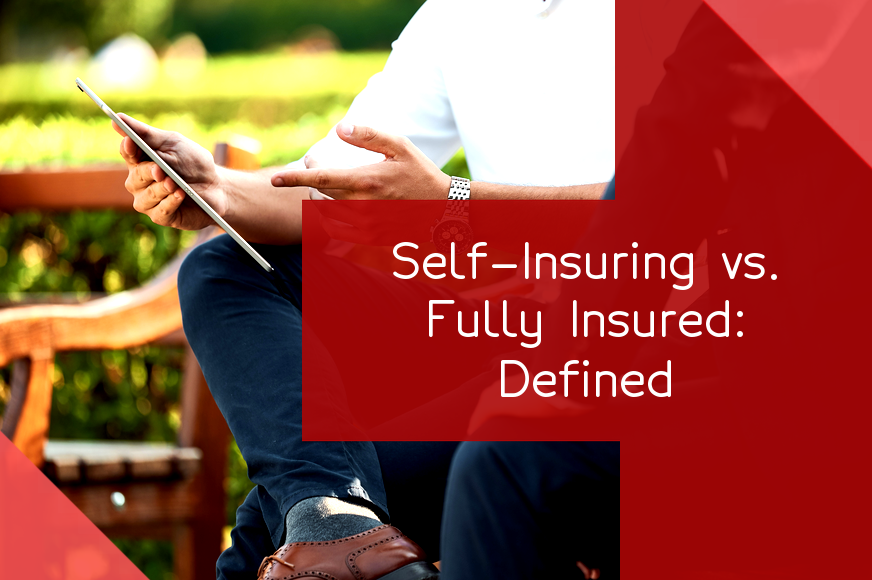Self-insurance is an alternative risk management strategy where businesses or individuals choose to bear the financial responsibility of potential losses instead of purchasing insurance policies from third-party companies. In the context of real estate, self-insuring means that the owner of the property sets aside sufficient funds to cover potential losses, such as damages or liability claims from third parties.
When a property owner decides to self-insure rather than purchasing a traditional insurance policy, they assume the risks associated with their property and accept the financial responsibility for any losses or damages. While self-insuring can be a cost-effective option for some property owners, it also carries a significant amount of financial risk since any loss or expense that arises must be paid for by the owner directly.
In contrast, fully insured means that the property owner has purchased a traditional insurance policy from a third-party insurance provider. The insurance company assumes the risks associated with property ownership, and the property owner pays premiums to the insurance company. In the event of a loss or damage, the insurance company is responsible for covering the costs, and the property owner's financial exposure is limited to the amount of their deductible.
Ultimately, the decision to self-insure or fully insure is a business decision that depends on the specific circumstances, risk tolerance, and financial goals of the property owner. Factors that may influence this decision include the value of the property, the likelihood of losses or damages, and the financial resources available to the property owner.
The Hidden Risk of Full Insurance Policies
Full insurance policies, which are also known as comprehensive insurance policies, are designed to provide coverage for a wide range of risks and events that may occur to a property. These policies generally cover both the structure of the property as well as any personal property or belongings that may be inside. While full insurance policies may seem like the perfect solution to protect real estate assets, there are hidden risks associated with these policies that buyers and investors must be aware of.
One of the main hidden risks associated with full insurance policies is the potential for inadequate coverage. While these policies seem comprehensive, they often have exclusions or limitations that may not be immediately apparent to a buyer or investor. For example, a policy may not cover certain types of damage such as flood damage or earthquake damage that may be specific to a particular location. Additionally, some policies may have limits on the amount of coverage that can be provided for certain types of damage or loss. Consequently, if a particular type of damage occurs that is not covered by the policy, the buyer or investor may be left with significant financial loss.
Another hidden risk of full insurance policies as they relate to real estate is the potential for disputes over coverage. Insurance companies are typically profit-driven and may dispute claims in an effort to limit payouts. If damage occurs to a property that is covered under a full insurance policy, the insurance company may claim that the damage was caused by certain exclusions or limitations within the policy, or that the coverage limits for that type of loss has been reached. This can lead to lengthy and expensive legal disputes between the insurance company and the property owner, further complicating matters.
Lastly, full insurance policies can also lead to complacency in maintaining and protecting the property. Property owners may believe that they are fully covered against all risks and therefore may not take adequate measures to maintain the property or protect it against certain types of damage or loss. For instance, the property owner may neglect to take measures to prevent fires or secure the property against burglaries since they believe that their full insurance policy will cover any damage or loss that may occur.
In conclusion, full insurance policies may seem like the perfect solution to protect real estate assets, but they do come with hidden risks that must be considered. Property owners and investors need to weigh the benefits of comprehensive policies against the potential for inadequate coverage, disputes over coverage, and complacency in maintaining and protecting the property. By doing so, they can make informed decisions and ensure that their real estate assets are adequately protected.
Types of Insurance You Can Self-Fund
Self-funding insurance simply means that the property owner assumes the risk and takes financial responsibility for covering the costs associated with an insured loss. This approach allows real estate investors to have more control over their insurance policies and the related costs. Here are some types of insurance that real estate investors might be able to self-fund:
- 1. Property Insurance: This type of insurance provides coverage for damage or loss of the property, and may include damage from fire, storms, theft, or vandalism. Self-funding property insurance requires property owners to absorb the costs of repairs or replacement of damaged items themselves.
- 2. Liability Insurance: Liability insurance is designed to protect the property owner from the legal responsibility associated with accidental injury or property damage incurred by someone else on their property. Property owners who opt to self-fund liability insurance coverage must be able to incur the costs of legal defense and any potential settlements.
- 3. Flood Insurance: Flood damage is not typically covered in standard property insurance policies, but it is an important policy for properties located in high-risk flood areas. Property owners who choose to self-fund their flood insurance must be able to absorb the full costs of any flood damage.
- 4. Title Insurance: Title insurance is often required by lenders to protect against loss caused by defects in a property's title. Self-funding title insurance coverage means that property owners, rather than a third party insurer, absorb the costs of any title defects.
- 5. Cyber Liability Insurance: With the increasing dependency on digital technologies in the real estate industry, cyber liability insurance provides coverage against data breaches, hacking, or other cyber attacks. Property owners who opt to self-fund cyber liability insurance must absorb the costs associated with legal and financial damage incurred related to cyberattacks.
Overall, self-funding insurance coverage is a strategy that property owners can use to reduce insurance costs and better manage risk. However, it's important to consider potential losses and have adequate financial resources to cover any damage or loss.
Insurance Policies You Do Usually Need
Insurance policies are important when it comes to real estate for several reasons. They provide protection for both the property owner and the mortgage lender.
Here are some of the common types of insurance policies required in real estate:
- 1Homeowners Insurance: This type of insurance protects the property owner against damage or loss of their property due to theft, fire, or other natural disasters. It also provides liability coverage in case someone is injured on the property. Homeowners insurance is usually required by the mortgage lender as a condition for getting a loan.
- 2Title Insurance: This type of insurance protects the lender and the homeowner against any title defects, liens, or other issues that may arise with the propertys ownership. Title insurance is usually required by the mortgage lender as a condition for getting a loan.
- 3Flood Insurance: This type of insurance is required for properties located in high-risk flood areas. Since standard homeowners insurance policies do not cover damage caused by floods, this insurance is necessary to protect both the lender and the borrower.
- 4Renters Insurance: This type of insurance is required for tenants who are renting the property. It provides coverage for personal belongings in the event of theft, damage, or loss due to fire or other natural disasters.
- 5Mortgage Protection Insurance: This type of insurance protects the lender in case the borrower is unable to repay their mortgage due to death, disability, or job loss.
In conclusion, insurance policies are essential in real estate to protect both the property owner and the lender. The type of insurance policy required depends on the specific property and its location. It's advisable to consult with an experienced insurance agent and a real estate attorney to ensure that you have the appropriate coverage for your needs.
Bottom Line: Self-Insurance vs. Fully Insured
Self-insurance and fully insured are two different methods of managing risks associated with real estate properties. The main difference between the two lies in who takes on the financial risk in the event of a loss.
In a traditional fully insured arrangement, the property owner pays a premium to an insurance company, which assumes the financial risks associated with the property. The insurance company covers the cost of any claims resulting from damage or liability incurred by the property owner. The property owner has no obligation to cover any losses beyond the premium paid.
In contrast, a self-insured property owner takes on the financial risks themselves. The property owner sets aside a certain amount of funds to cover any potential damage or liability claims. The property owner is solely responsible for any losses beyond the amount set aside. This can be achieved either through a self-insurance fund or by purchasing an insurance policy with a high deductible.
The decision to choose either self-insurance or a fully insured approach can have a significant impact on the bottom line of a property owner's financials. Self-insurance typically involves lower costs than buying an insurance policy, but it also means that the property owner is taking on more financial risk.
For example, if a fully insured property owner experiences a loss, the insurance company covers the cost of the loss, and the property owner only has to pay the premium. On the other hand, if a self-insured property owner experiences a loss, the property owner is responsible for covering the cost of that loss, resulting in a higher direct cost to the owner.
In conclusion, the decision to use self-insurance or fully insured strategy can significantly affect a property owner's bottom line. While self-insurance comes with lower premiums, it also carries higher risk and requires a more significant commitment of funds to cover losses. Fully insured, on the other hand, can provide more comprehensive coverage but can be more expensive in terms of premiums.
Just one more thing: if you liked the article, please like us on social media and share this article with friends.



